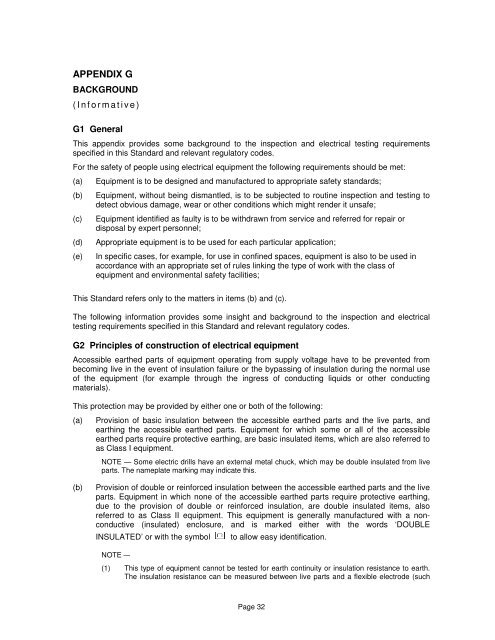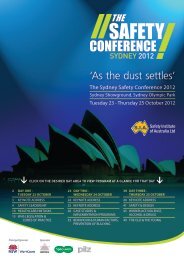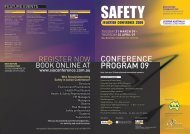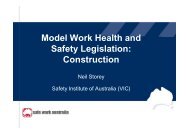In-service safety inspection and testing of electrical equipment
In-service safety inspection and testing of electrical equipment
In-service safety inspection and testing of electrical equipment
Create successful ePaper yourself
Turn your PDF publications into a flip-book with our unique Google optimized e-Paper software.
APPENDIX GBACKGROUND( I n f o r m a t i v e )G1 GeneralThis appendix provides some background to the <strong>inspection</strong> <strong>and</strong> <strong>electrical</strong> <strong>testing</strong> requirementsspecified in this St<strong>and</strong>ard <strong>and</strong> relevant regulatory codes.For the <strong>safety</strong> <strong>of</strong> people using <strong>electrical</strong> <strong>equipment</strong> the following requirements should be met:(a)(b)(c)(d)(e)Equipment is to be designed <strong>and</strong> manufactured to appropriate <strong>safety</strong> st<strong>and</strong>ards;Equipment, without being dismantled, is to be subjected to routine <strong>inspection</strong> <strong>and</strong> <strong>testing</strong> todetect obvious damage, wear or other conditions which might render it unsafe;Equipment identified as faulty is to be withdrawn from <strong>service</strong> <strong>and</strong> referred for repair ordisposal by expert personnel;Appropriate <strong>equipment</strong> is to be used for each particular application;<strong>In</strong> specific cases, for example, for use in confined spaces, <strong>equipment</strong> is also to be used inaccordance with an appropriate set <strong>of</strong> rules linking the type <strong>of</strong> work with the class <strong>of</strong><strong>equipment</strong> <strong>and</strong> environmental <strong>safety</strong> facilities;This St<strong>and</strong>ard refers only to the matters in items (b) <strong>and</strong> (c).The following information provides some insight <strong>and</strong> background to the <strong>inspection</strong> <strong>and</strong> <strong>electrical</strong><strong>testing</strong> requirements specified in this St<strong>and</strong>ard <strong>and</strong> relevant regulatory codes.G2 Principles <strong>of</strong> construction <strong>of</strong> <strong>electrical</strong> <strong>equipment</strong>Accessible earthed parts <strong>of</strong> <strong>equipment</strong> operating from supply voltage have to be prevented frombecoming live in the event <strong>of</strong> insulation failure or the bypassing <strong>of</strong> insulation during the normal use<strong>of</strong> the <strong>equipment</strong> (for example through the ingress <strong>of</strong> conducting liquids or other conductingmaterials).This protection may be provided by either one or both <strong>of</strong> the following:(a)Provision <strong>of</strong> basic insulation between the accessible earthed parts <strong>and</strong> the live parts, <strong>and</strong>earthing the accessible earthed parts. Equipment for which some or all <strong>of</strong> the accessibleearthed parts require protective earthing, are basic insulated items, which are also referred toas Class I <strong>equipment</strong>.NOTE — Some electric drills have an external metal chuck, which may be double insulated from liveparts. The nameplate marking may indicate this.(b)Provision <strong>of</strong> double or reinforced insulation between the accessible earthed parts <strong>and</strong> the liveparts. Equipment in which none <strong>of</strong> the accessible earthed parts require protective earthing,due to the provision <strong>of</strong> double or reinforced insulation, are double insulated items, alsoreferred to as Class II <strong>equipment</strong>. This <strong>equipment</strong> is generally manufactured with a nonconductive(insulated) enclosure, <strong>and</strong> is marked either with the words ‘DOUBLEINSULATED’ or with the symbolto allow easy identification.NOTE —(1) This type <strong>of</strong> <strong>equipment</strong> cannot be tested for earth continuity or insulation resistance to earth.The insulation resistance can be measured between live parts <strong>and</strong> a flexible electrode (suchPage 32
















